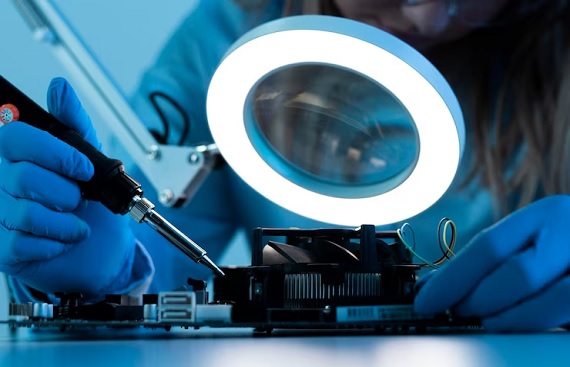The Rise of Pico Technology

In the vast realm of scientific discovery and technological advancement, there exists a hidden frontier that holds the key to unlocking the mysteries of the universe. This frontier is Pico Technology, a domain of measurement and manipulation at the atomic and subatomic levels. The rise of Pico Technology represents a seismic shift in our understanding of precision measurement and its applications across diverse fields, from biology to quantum computing. Pico Technology, at the intersection of precision measurement and quantum effects, represents the forefront of scientific and technological progress, unveiling the remarkable capabilities of working at the picoscale, offering unprecedented precision and reactivity that are reshaping fields ranging from medicine to green energy.
Unlocking the Picoscale World
At the heart of Pico Technology lies the ability to work at the picoscale, a dimension where a picometer, often represented as 1 x 10^-12 meters, reigns supreme. The term ‘pico’ itself is derived from the Greek word ‘pikos’, meaning ‘very small’. What sets Pico Technology apart is not just its capacity to delve deeper into smaller scales, but its unique ability to harness the inherent physical, chemical, mechanical, and optical properties of materials that naturally manifest at the picoscale.
Transitioning from the macroscopic world to the picoscale, where particles are a mere trillionth of a meter triggers a profound transformation in material properties governed by quantum effects. At this scale, properties like melting points, fluorescence, electrical conductivity, magnetic permeability, and chemical reactivity undergo size-dependent changes. Picoscale gold, for instance, appears in vibrant red or purple hues, distinct from its typical yellow appearance. This nanoscale transformation stems from the confinement of gold electrons, leading to unique interactions with light. Practical applications include the selective accumulation of picoscale gold particles in tumors for precise imaging and targeted laser destruction. This realm also introduces ‘tunability’, allowing scientists to fine-tune material properties by adjusting particle size, and ‘tunneling’, a fundamental concept in scanning tunneling microscopes and flash memory for computing.
Pico Technology in the Biological World
![]()
Nature, over millennia, has perfected the art of biology at the picoscale. Many of the inner workings of cells naturally occur at this scale, where biomolecules such as hemoglobin, the oxygen-carrying protein in the human body, measure a mere 5.5 nanometers in diameter. Even a strand of DNA, a fundamental building block of life, is only approximately 2 nanometers in diameter. While these dimensions are larger than a picometer, they serve as a testament to the natural picoscale within biology.
Drawing inspiration from nature's picoscale, medical researchers have embarked on designing tools, treatments, and therapies that offer higher precision and personalization than traditional methods. These innovations are administered earlier in the course of diseases, resulting in fewer adverse side effects. One such medical application of Pico Technology is the bio barcode assay. This method, relatively low in cost, detects disease-specific biomarkers in the blood, even when present in minimal quantities. By attaching ‘recognition’ particles and DNA ‘amplifiers’ to picoscale gold particles, this assay has demonstrated remarkable sensitivity compared to conventional methods. It can adapt to detect a wide range of molecular targets, offering a transformative approach to disease diagnosis and monitoring.
Pico Technology Beyond Medicine
![]()
The profound understanding of picoscale biomolecular structures extends its impact beyond the realm of medicine. Scientists explore the utilization of picoscale biological principles, including molecular self-assembly, self-organization, and quantum mechanics, to create novel computing platforms. These platforms offer innovative solutions that can revolutionize computation and data processing. Another noteworthy application is the realm of green energy, where the energy harvested from sunlight in plants is transferred to plant ‘reaction centers’ with nearly 100% efficiency, thanks to quantum mechanical processes at the picoscale. Researchers are investigating photosynthesis as a model for ‘green energy’ picosystems, with the aim of producing and storing non-polluting solar power in an inexpensive and environmentally friendly manner.
Picoscale Materials and Their Enhanced Properties
![]()
One of the distinguishing features of materials at the picoscale is their significantly larger surface areas when compared to larger-scale counterparts with the same mass. This increased surface area enables a more extensive interaction with surrounding materials, significantly affecting reactivity.
Consider the concept of a cubic nanoparticle, where each cube has a volume of 1 cubic centimeter and is filled with picoscale cubes, each with a surface area of 6 square nanometers. The total surface area of this single cubic centimeter of picoscale material reaches a staggering 6,000 square meters. In essence, picoscale materials offer vast surface areas, surpassing even nanoscale materials, which themselves exhibit impressive surface area characteristics. This extraordinary surface area property of picoscale materials has far-reaching implications.
Catalysis and Energy Applications
Materials with extensive surface areas at the picoscale exhibit remarkable catalytic prowess, a fact that has already begun reshaping the global catalyst market, influencing industries worth billions, including oil and chemicals. From catalytic converters in vehicles reducing exhaust toxicity to potential revolutions in batteries, fuel cells, and catalysts, picoscale materials hold the promise of cleaner, safer, and more cost-effective energy production and storage. Beyond catalysis, their high surface area plays a pivotal role in applications like water treatment, desalination, and functionalizing picoscale materials for purposes ranging from drug delivery to clothing insulation. These characteristics are poised to drive efficiency, sustainability, and environmental friendliness across multiple industries.
But the journey doesn't end here. The term ‘Pico Technology’ hints at the future horizons of technology manipulation, and as we explore the picoscale, we inevitably ponder what lies beyond. A hypothetical advancement known as ‘femtotechnology’ looms on the horizon, envisioning the manipulation of matter at the subatomic level, pushing the boundaries of what we thought was possible.
Read More News :
